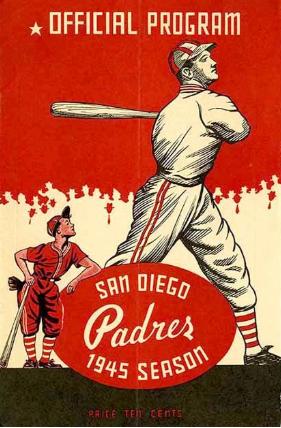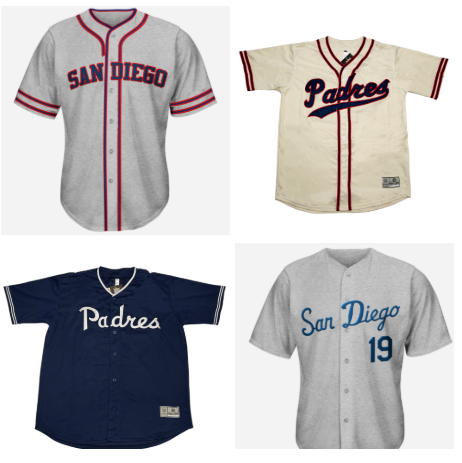Pacific Coast League (1936-1968)
Tombstone
Born: February 1, 1936 (Hollywood Stars relocate to San Diego)1Coast League Voting on Franchise Change, UP via The Bend Bulletin, Bend, OR, February 1, 1936
Relocated: August 15, 1968 (Eugene, OR, announced)2Eugene Moves to Top of Minors in One Giant Stride, Eugene Register-Guard, August 16, 1968
First Game: March 31, 1936 (W 6-2 vs. Seattle Indians)3City turned out for the opening of Pacific Coast league baseball in 1936, The San Diego Union-Tribune, Mar. 31, 2023
Last Game: September 8, 1968 (W 8-7 vs. Phoenix Giants)4Good-bye Pads…End PCL Play, AP via The Spokesman Review, Spokane, WA, Sep. 9, 1968
Pacific Coast League Champions: 1937, 1954, 1962, 1964, 1967
Stadiums
San Diego Stadium (1968)
Opened: August 20, 1967
Demolished: December, 2020-March, 2021
Westgate Park (1958–1967)
Opened: April 28, 1958
Demolished: 1969
Lane Field (1936–1957)
Opened: March 31, 1936
Closed: September 8, 1957
Marketing
Team Colors: Navy, Red, White
Ownership & Affiliation
Owners:
- Bill Lane(1936-1938)
- Bill Lane Estate (1939)
- M.L. Clark (1939-1944)
- Bill Star et al (1944-1955)
- C. Arnholt Smith (1955-1968)
Major League Affiliations:
- Philadelphia Phillies (1966–1968)
- Cincinnati Reds (1962–1965)
- Chicago White Sox (1960–1961)
- Cleveland Indians (1949–1951, 1957–1959)
- Boston Red Sox (1936)
Background
The original San Diego Padres played in the Pacific Coast League (PCL) from 1936 to 1968. The team was established in 1903 as the Sacramento Solons, a founding member of the PCL. The team became the Tacoma Tigers in 1904 and won the PCL title before moving back to Sacramento for the 1905 season, then dropped out of the loop altogether.
Our Favorite Gear
San Diego Padres PCL Jerseys
When it comes to replica jerseys, we turn to our friends at Royal Retros, who put extraordinary detail into their fully customizable baseball jerseys, including those for the San Diego Padres of Pacific Coast League (1936-1968)
Free Customization Included
Each jersey individually handmade
Any name and number
Sewn tackle twill crest, numbers & letters
100% polyester
Heavyweight fabric made to game standards
Fight strap included
Relive the early days of professional baseball in San Diego in a great replica jersey from Royal Retros. Multiple styles available.
They returned in 1909 and played five and half seasons in Sacramento. They were alternately known as the Sacts or Senators. On February 14, 1913, they became known as the Wolves after hiring Henry Wolverton as manager.5Baseball Germ is Rampant in Capitol, Oxnard Courier, Feb. 28, 1913 Halfway through the 1914 season, the team relocated to the Mission District of San Francisco. There, they were known as the San Francisco Missions and the Mission Wolves.
A grain of Salt
Utah businessman Bill Lane bought the Missions and on December 17, 1914, was granted permission from the PCL to move the team to Salt Lake City, where they became the Bees. During the winter of 1926, Lane moved the team to Hollywood. Originally, they were going to be called the Hollywood Bees, but before the season started, Lane decided to rename them the Hollywood Stars.
The team played at Wrigley Field, home of fellow PCL club, the Los Angeles Angels. The Stars won the PCL pennant in 1929 and 1930. However, the stadium arrangement meant the Stars were the Angels’ tenants. In 1935, after the Angels doubled the Stars’ rent, Lane moved the club south to San Diego and renamed them the Padres.
America’s Finest City
An old U.S. Navy athletic field in downtown San Diego next to Coronado Bay was quickly upgraded for use by the Padres. Lane was able to get the project done under the Depression-era program known as the Works Progress Administration. It was finished in time for opening day, March 31, 1936, as the Padres hosted the Seattle Indians at the appropriately renamed Lane Field. Lane, unfortunately, passed away two years later after suffering a heart attack late in the 1938 season. His estate ran the team until 1939, when it was sold to M.L. Clark.
On the field, the Padres were competitive but not dominant. One of their first stars was a local kid by the name of Ted Williams. He was offered a contract by the New York Yankees, but since he was still in high school, his mother wouldn’t co-sign the offer. Instead, she let him play for the hometown Padres at a salary of $150 a month. In his second season with the club, he batted .349 and homered in all eight PCL ballparks. The Padres’ parent club, the Boston Red Sox, then signed Williams for $25,000 and sent him to their American Association club Minneapolis.
Fun in the sun
Even with the loss of Williams, the club was competitive, usually posting a winning record up until World War II. Beginning in 1946, the PCL, previously ranked as a double-A league, was re-classified as triple-A. It took a while for the Padres to get back up to speed, though.
By 1949, they had turned things around and finished with a winning record (96-92) before improving to 114-86-1 and a second-place finish the following year. They stumbled for the next few seasons before finally capturing the PCL pennant in 1954.
In 1955, the team was purchased by the Westgate-California Tuna Packing Co., owned by C. Arnholt Smith. While the team was a huge success on the field and at the gate, it faced many challenges, the most dire surfacing in 1957. That year, the Brooklyn Dodgers and New York Giants announced their intentions to move to Los Angeles and San Francisco, respectively. Those were two of the PCL’s biggest markets. Many felt these relocations would kill the PCL.
PCL killers?
Not only would the major league teams’ arrivals wipe out the San Francisco Seals and Los Angeles Angels, but the Hollywood Stars, Sacramento Solons, and quite likely, the Padres, only 90 minutes from L.A. In early 1957, as reports of the two teams relocating first began to circulate, the Padres’ president James Mulvaney insisted his fellow PCL clubs immediately declare major league status.6Growing Opposition to Dodgers PCL Bid, The Vancouver Sun, Feb. 22, 1957
Undaunted by the threat to the PCL and the Padres, Smith set about building a new, state-of-the-art ballpark in the then undeveloped Mission Valley section of San Diego. Smith’s approach was the correct one as the PCL did survive, though teams in the loop’s smaller markets did struggle.
On with the show
Pressure on Major League Baseball to expand into new markets, spurred by the relocation of the Dodgers and Giants to the West Coast, continued on many fronts. Oddly, San Diego wasn’t one of the cities mentioned as a possible market for an MLB team. While many other cities attempted to woo existing teams or court the two leagues for an expansion team, San Diego quietly got to work.
After the onfield and box office success of the local American Football League team, the San Diego Chargers, the city decided to build a new multi-purpose stadium. So thrilled was Chargers owner Baron Hilton by this development that he pledged to help the city land an MLB team. With the stadium nearing completion on March 1, 1967, C. Arnholt Smith and the San Diego Baseball Co. formally submitted their expansion application to Major League Baseball. Just over a year later, on May 28, 1968, San Diego, along with another dark horse, Montreal, was admitted to the National League.
The PCL Padres were already well into the 1968 season when the news was announced. Their parent club, the Philadelphia Phillies, made arrangements to relocate the minor league Padres to Eugene, Oregon, though they left the nickname behind.


